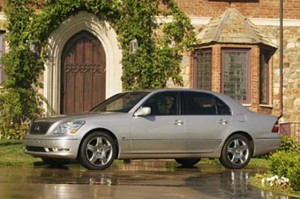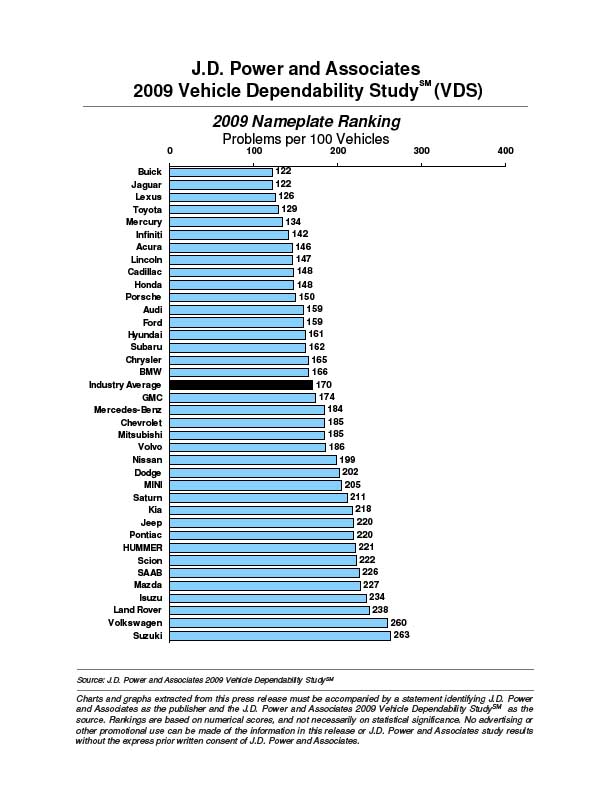
Lexus slips to third in the Power Dependability Study, but still scores a best-ever with its 2006 LS430.
Perennial quality leader Lexus was nudged aside by two determined challengers in the latest study of automotive reliability. Buick and Jaguar led the list of brands that maintain their quality, even after three years on the road, according to the 2009 Vehicle Dependability Study.
The annual study found that Buick and Jaguar are the two new benchmarks in auto reliability, based on more than 50,000 surveys of U.S. motorists driving vehicles from the 2006 model-year. But Lexus still has reason to be proud. Four of its models took top honors in individual product categories – including the LS430, ranked number one among “Large Premium Cars.” In fact, the LS sedan experienced a mere 61 problems per 100 vehicles (PP100) on the road, an all-time low, even accounting for changes made to the 2009 VDS survey.
The Dependability Study is one of a series of surveys the California-based Power conducts each year. Perhaps the best known is the Initial Quality Study, or IQS, which asks owners to report on problems they experience during the first 90 days of ownership. That’s become a real battleground among manufacturers, and has seen huge improvements, across the industry, in recent years.
Improving long-term reliability, experts stress, is a much more difficult challenge, and according to Power’s product research director, Neal Oddes, it is likely to have a significant impact, not only on the way an owner perceives a brand, but “it is (also) a good indicator of whether a consumer will repurchase a vehicle and recommend it to their friends.”
It’s difficult to make an apples-to-apples comparison between the newest VDS and previous years’ studies due to changes Power made for 2009, both to account for new technologies showing up in more vehicles – like MP3 players and navigations systems – and also to reduce ambiguity in the results. Nonetheless, Oddes said the trendline towards better reliability continues.
And, for the most part, manufacturers held steady in terms of their rankings, despite the slight slide by Lexus.
Toyota came in fourth, followed by Mercury, Infiniti, Acura, Lincoln, Cadillac and Honda, which rounded off the Top 10. Significantly, six of Detroit’s brands ranked above the industry average of 170 PP100. The domestics “are slowly closing the gap,” Oddes told TheDetroitBureau.com, “though there is still room for improvement.” GM’s Hummer and Pontiac brands, for example, fell into the bottom 10, along with Chrysler’s Jeep.
On the whole, the Japanese “continue to do well,” added Oddes, and “are still leading the way in terms of long-term quality. But all the other manufacturers are starting to catch up.” As with Detroit’s Big Three, the Japanese were all over the VDS map. The Toyota division was not only fourth, overall, just behind its high-line Lexus brand, but scored wins in five individual segments. Then there’s Suzuki, with an average 263 problems, the bottom-ranked brand.
That Japanese maker came in just slightly below two perennial quality laggards, Volkswagen, with 260 PP100, and Land Rover, with 238. Indeed, Europeans didn’t fare all that well, this year, with only Jaguar in the Top 10, and Porsche, in the number 11 slot with 150 problems, the only German maker to do better than industry average.
There’s often – though not always – a close correlation between a manufacturer’s performance in the short-term IQS and the VDS’s long-term metrics. If that holds true, Oddes said he believes the Germans will start showing strong improvement next year. They began to post significant improvements in initial quality in the 2007 IQS.
The same should be true, he forecasts, for the Koreans. Hyundai has shown notable improvements in both initial and longer-term quality, in recent years, though its sibling Kia brand still scored well below the industry average in the 2009 VDS.
Even weak brands can deliver a winner. Mazda, which ranked fifth from bottom, overall, scored a first place finish, with its MX-5 Miata, in the Compact Sporty Car segment.
Curiously, problems that show up in the IQS don’t necessarily reappear when owners are surveyed three years later. That’s particularly true with new technology, which Power bored in on with the latest dependability questionnaire. Some of the new infotainment systems initially frustrate owners with their complicated control systems, but after three years, suggested Oddes, “owners have had time to learn how to deal with it, so problems work their way out.”
Equally important, the 2009 VDS shows that most high-tech hardware is holding up, unlike consumer electronic devices, which seem programmed to fail relatively quickly.
Ironically, there may be a down-side to the steady improvement in vehicle reliability, according to Oddes. “Manufacturers have done such a good job improving quality,” he explained, that there’s less reason to trade in, especially in the current recession. Meanwhile, “It’s also improved things on the used car side,” so financially-strapped motorists have another alternative to buying new.

The dependability gap is closing, but there are still big differences, top to bottom.
